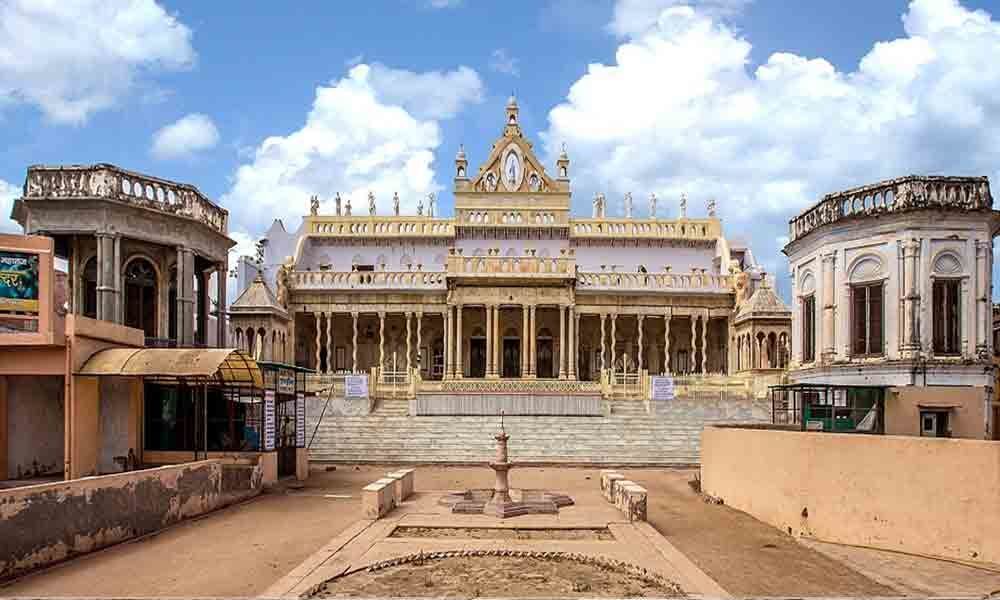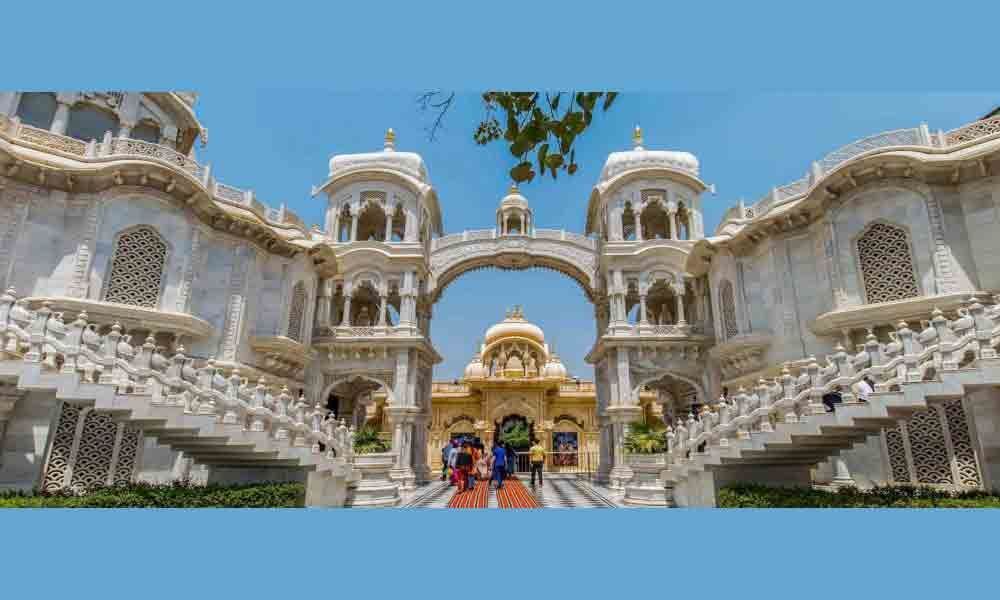Live
- Promoting Sports and Athletes is Telangana Government’s Priority – MLA Rajesh Reddy
- CM Revanth Reddy Urges Tollywood to Collaborate on Social Issues
- Karnataka BJP Protests Congress Over Alleged Misuse Of Public Funds
- Thousands Pay Tribute to Lance Havaldar Anoop Poojary in Udupi
- People should take advantage of Pradhan Mantri Surya Ghar: Muft Bijli Yojana: PM
- Tata Group to create 5 lakh manufacturing jobs over next half decade: N. Chandrasekaran
- Hansika’s charm remains undeniable
- Housing Sales Decline 4% in 2024, but Sales Value Rises 16% in India’s Top Cities: ANAROCK
- VHP to launch campaign from Jan 5 to free temples from govt control
- Israeli far-right minister visits flashpoint Jerusalem holy site, sparking criticism
Just In
Yes, most people go to Mathura-Vrindavan on a pilgrimage. After all, the twin cities are crowded with temples, new and old. The whole region is considered one of India's most sacred site since Lord Krishna was born here and lived for many years before he left for Dwaraka.
The region is full of temples to him and legends about his life and 'leelas' are depicted everywhere. For the devout Hindu, this is one of the seven 'Mukti Ksethrams' or 'Sapta Puri' of India.
However, Mathura-Vrindavan is also about great cuisine including amazing street food. There are few places in India, where you can find such an abundance in variety and quantity of milk and yoghurt-based items.
As for savouries, the Satvik Samosas and Kachoris are among the countless delights. Mathura also has one of north India's finest museums showcasing rare and exquisite historical artefacts.
Given that Agra and its iconic Taj Mahal, are only around 60 km away, most visitors tend to club the three cities in one holiday. However, we had seen Agra several times, so we decided to stick to the twin cities. I had been to Mathura twice before, but years had elapsed, and I was eager to see if anything had changed.
Visitors can start with Vrindavan, and then go on to Mathura. Or vice-versa. We, however, started with Mathura and went back and forth according to our photography requirements—certain places are best photographed during certain times of the day. Our taxi-driver thought that meant extra miles and fatigue, but we wanted it that way.
Mathura's most revered site is the Krishna Janmabhoomi temple and we began with that—after some amazing masala-chai made with cow milk. The temple was where Krishna was born in a small prison cell, and where his parents Devaki and Vasudeva were imprisoned by Krishna's maternal uncle, Kamsa.
After the darshan and admiring the decorative artwork we partook of the prasad of makhan-mishri. There are several eateries around this temple, so we had breakfast at one going for well-known local dishes like dubki wale aloo with puris; jalebi with spongy khamans; and dahi bhalla.
We then proceeded to the massive and magnificent Kusum Sarovar, a sandstone monument with a picturesque setting. The reflections make for superb shots and it is a photographer's delight. We later visited the very colourful and aesthetically designed Dwarakadheesh Temple where the bhog (prasad) was truly delicious.
We drove to renowned sweet shops like Brijwasi Mithaiwala, Gosai Pede Wala and Shankar Mithaiwala to pick up local delicacies to take home, beginning with the legendary Mathura Peda of which one finds several varieties across the twin cities; soan-papdi, the fabulous ghewar with its thick layer of dry fruits, rabri, rasmalai, rasagulla, petha, ghujias, chhenna, etc.
For lunch, we headed to Tripti restaurant in Nidhivan Sarovar Portico hotel as we were told their thali is the best in town and their buffet features authentic local cuisine. Walking through the spacious lobby redolent with the fragrance of sandalwood incense, we reached the Tripti restaurant. It was indeed a delicious meal and the chefs told us the history of many of the region's delicacies. The rasamalai, rabri, dhokla, bhalle papdi, chaats, koftas, kachoris and puris were among the highlights at Tripti restaurant. On our way out, the hotel concierge guided us to the best stores for local handicrafts.
Anyone shopping here will notice that idols and figurines, paintings, wall-plates, and door curtains all featuring Krishna, either stand-alone or with Yashoda or Radha or Rukmini are widely sold here. Aside from these were the other handcrafted products that Uttar Pradesh is renowned for.
In fact, you will find images of Krishna in virtually every restaurant, dhaba, sweetshop, home and commercial establishment around these twin cities. The Brijwasi and Shankar sweetshops were full of his pictures. I recalled that even the aesthetically designed interiors of Nidhivan Sarovar Portico had large images and paintings of the flute-playing Krishna with cowherds on walls and niches.
We next visited Vishram Ghat. There are around 25 ghats on the banks of river Yamuna but Vishram Ghat is the holiest as it is believed that Krishna washed his feet here and rested after slaying Kamsa. The currents in the Yamuna here can be swift so don't venture too far unless you are a swimmer. I kept far away from the waters!
Towards evening, it was still very warm, so we stopped for lassi at the famous Nathoo Lassi Wala and Mathura Walo Ki Pracheen Dukaan. Actually, both cities abound in places selling all varieties of Thandais as also lassi, both sweet and salty, especially Malai Lassi. We also had Satvik Samosas i.e. sans onion. In fact, the no-onion, the no-garlic rule is widely prevalent in Mathura-Vrindavan eateries.
We then had a quick look at the architecturally impressive Jama Masjid and its fine mosaics. Dinner was about street food. We gorged on samosas, kachoris, jalebis, dhoklas, Bedmi puris, and golgappas of various flavours.
Next day, after an early breakfast and more masala chai drunk out of kulhads we headed to the Government Museum, Mathura. It boasts a vast treasure of historic items – coins, status, pottery, sculptures, paintings, manuscripts and so on. The specimens from the Mathura School of Art are particularly impressive.
We then drove on to Vrindavan. The Govardhan Hill was our first stop—the legendary hill around which Krishna and Balarama played and which Krishna later lifted and held aloft with his finger for seven days, so the residents of his Mathura found shelter underneath and were saved from Indra's wrath.
The spectacular ISKCON temple in Vrindavan is a white marble structure with a beautiful courtyard. It also has a kitchen where they serve Annaprasadam, which is a hot and scrumptious meal of sathvik cuisine. We had our lunch here and moved on to the imposing sandstone Govind Deo temple with its lotus ceiling, but which was much destroyed by marauding armies, so the presiding deity's idol was shifted and is now in Jaipur.
The superb craftsmanship of Shahji temple makes it a must-see. Its exterior has an oddly Western classical look and reminded me of European palaces. Inside are Belgian chandeliers, impressive spiral marble columns, painted ceilings and depictions of Ras Leela.
In between these visits, we stopped at several sweet shops and Street-side eateries to pick up packets of sweets to take home even as we snacked on dahi vadas, kachoris, tikkis, pakodas, and ghee-soaked sweets...just like Mathura.
We finally got to see the Vrindavan's best-known temple, the Banke Bihari temple where Krishna is seen as Banke (meaning bent) or Tribhangi or Tribhanga. Legend has it that this black idol was found by musician-saint Swami Haridas (guru of Tansen). A curtain is drawn over the deity and opened every now and then as it is believed that his image of Krishna is so stunningly beautiful it will cause the onlooker to become unconscious if he gazes continuously on the idol! Temple bells are not used to awaken the god in the morning as at other temples, they believe Krishna here is a child and the sound will startle him!
We headed to the pristine white Prem Mandir in the evening as it sports special lighting and musical fountain switched on at night. Krishna is depicted in various sculptures here as are Ram and Seeta.
We wanted to have dinner in Vrindavan but one of our friends insisted on returning to Mathura and Nidhivan Sarovar Portico hotel where the chefs had promised her details for her story on Chhappan Bhog (56 delicacies) given as prasad in north Indian temples. So, as she made notes, we sat at Tripti restaurant and feasted on their spread of ghee-laden rice varieties, kadi-pakoda, gobi parathas, chhole-bhature, moong-dal kachoris, etc, ending with a delectable Thandai—a sweet, thickened-milk drink topped with cardamom-flavoured cream and filled with crushed nuts and dry fruits.
Next morning, we headed back to Vrindavan and saw the Radha-Raman temple and Madan-Mohan temple. Next was the Rangaji temple, which is in largely south-Indian architectural style and dedicated to Lord Ranganatha.
We finally visited Seva Kunj, the place where Radha and Krishna used to sport. The serene Nidhivan is where Krishna rested with Radha. It is believed that even now, Krishna visits the temple here every night to dance with the gopikas. The priests even leave items for Krishna's use every night and the story goes that they find the signs of use when they open the doors in the morning! Hence the temple is completely closed, and no one is allowed to enter once night falls to allow privacy for Krishna and his gopikas!
We, unfortunately, had no time for Gokul and Nandagram, the places where Krishna spent his childhood with his foster parents Yashoda and Nanda. After some more shopping, we got back just in time to catch the train to Delhi.

© 2024 Hyderabad Media House Limited/The Hans India. All rights reserved. Powered by hocalwire.com











